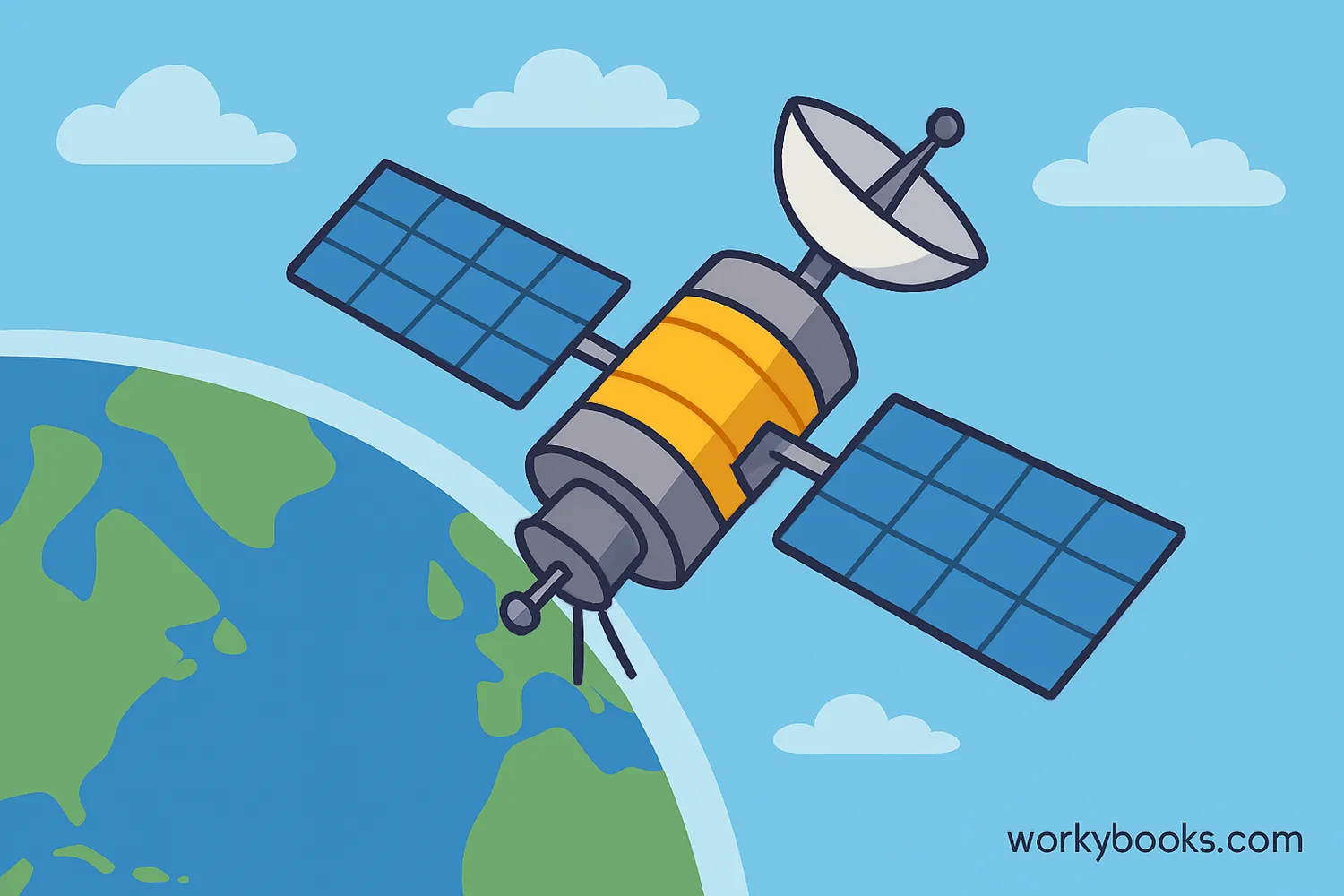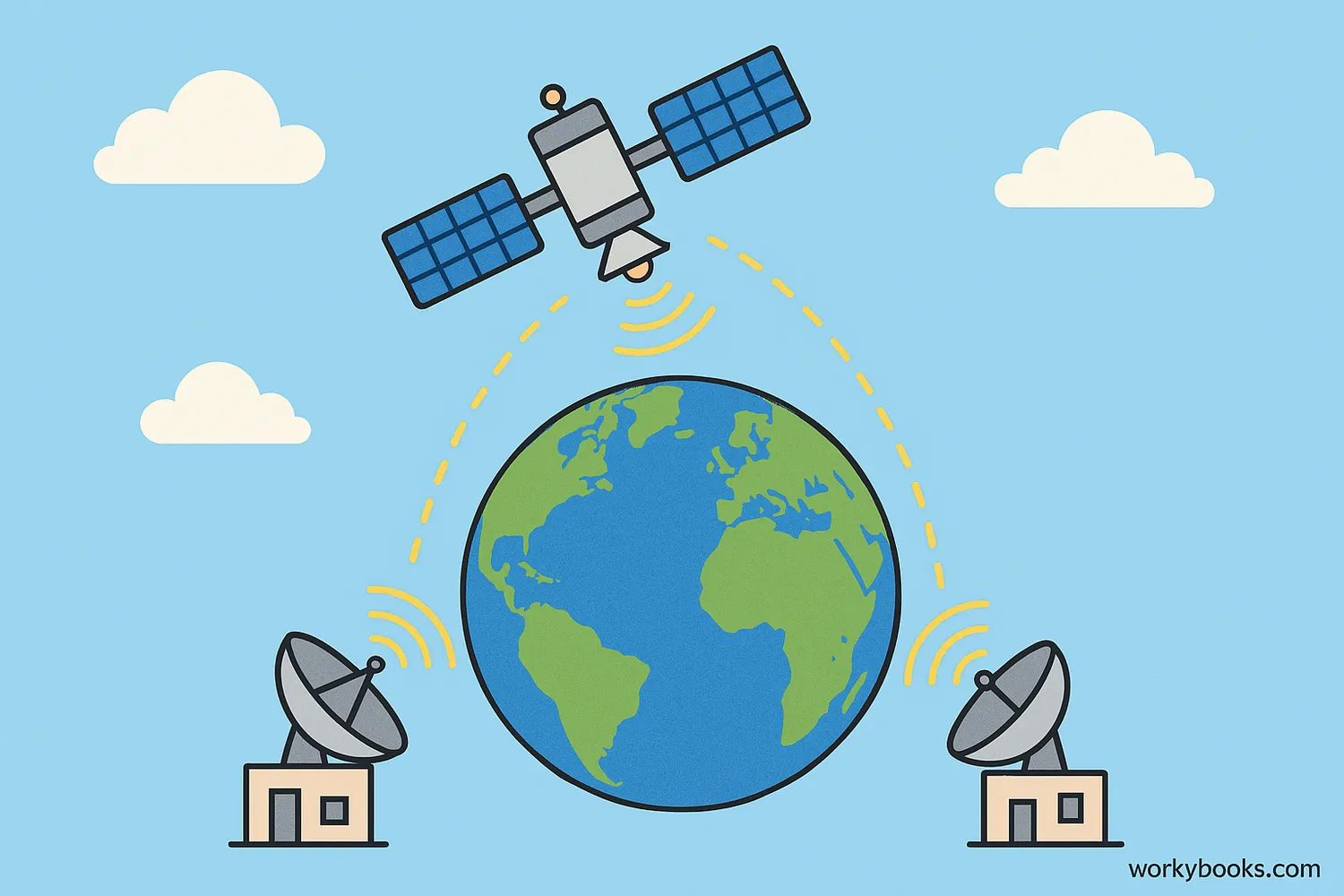Artificial Satellites - Definition, Examples, Quiz, FAQ, Trivia
Discover how humans send objects into space to orbit Earth and help us in many ways!
What is an Artificial Satellite?

An artificial satellite is a human-made object that orbits, or travels around, Earth or other bodies in space. Unlike natural satellites like our Moon, artificial satellites are built by people and launched into space using rockets.
The first artificial satellite was called Sputnik 1, launched by the Soviet Union in 1957. Since then, thousands of satellites have been sent into space by many countries. These satellites help us with weather forecasting, television signals, navigation, scientific research, and much more!
Satellite Fact!
There are over 3,000 active satellites currently orbiting Earth, and thousands more inactive ones!
How Satellites Work

Satellites work by balancing two important forces: gravity and forward motion. Earth's gravity pulls the satellite toward our planet, while the satellite's forward motion tries to carry it away in a straight line. These forces balance each other to create a stable orbit.
Most satellites have these key parts:
Power System
Solar panels that convert sunlight into electricity
Communication
Antennas to send and receive signals
Instruments
Cameras, sensors, or other tools for their mission
Propulsion
Small rockets to adjust their position
Satellites follow specific paths called orbits. The most common types are:
• Low Earth Orbit (LEO): 160-2,000 km above Earth - used for imaging and science
• Medium Earth Orbit (MEO): 2,000-35,000 km - used for navigation like GPS
• Geostationary Orbit (GEO): 35,786 km - stays above the same point on Earth
Orbital Velocity!
To stay in orbit, satellites must travel at incredible speeds - about 28,000 km/h for low Earth orbit! That's 20 times faster than a commercial jet.
Types of Satellites and Their Uses
Satellites come in many different types, each designed for specific jobs. Here are some of the most important kinds:
Communication
Send TV, radio, phone, and internet signals around the world
Weather
Monitor clouds, storms, and climate patterns to help forecast weather
Navigation
Provide GPS signals that help us find locations and navigate
Earth Observation
Take pictures of Earth to study agriculture, forests, and urban growth
Scientific
Study space, stars, planets, and other celestial objects
Military
Used for national security, surveillance, and defense purposes
Each type of satellite has special equipment designed for its job. Weather satellites have special cameras to see cloud patterns, while communication satellites have large antennas to send and receive signals. Scientific satellites might have telescopes to look deep into space or sensors to measure space weather.
Launching Satellites into Space

Getting satellites into space is a complex process that requires powerful rockets. Satellites are carefully packed inside the rocket's payload fairing (the nose cone) to protect them during launch.
The launch process involves several important steps:
Launch
Powerful rockets lift the satellite off Earth
Stage Separation
Rocket stages fall away as fuel is used up
Orbit Insertion
The satellite is released into its planned orbit
Deployment
Solar panels and antennas unfold
Operation
The satellite begins its mission
Satellites are launched from special locations called spaceports that are usually near the equator. This location gives rockets an extra boost from Earth's rotation, helping them reach orbit more efficiently.
Once in space, ground controllers communicate with the satellite to make sure all systems are working properly. They can send commands to adjust the satellite's position or change what it's doing.
Rocket Science!
It takes more energy to launch a satellite into orbit than to send it to other planets! About 90% of a rocket's weight is fuel needed to reach orbit.
Satellite Knowledge Quiz
Test what you've learned about artificial satellites with this quiz!
Frequently Asked Questions
Here are answers to some common questions about artificial satellites:
Space Technology Trivia
Discover some amazing facts about artificial satellites and space technology!
Satellite Speed
The International Space Station travels at about 28,000 km/h, completing an orbit around Earth every 90 minutes! That means astronauts see 16 sunrises and sunsets every day.
GPS Precision
The GPS system uses at least 24 satellites working together. Your phone or navigation device needs signals from at least 4 GPS satellites to determine your exact location on Earth!
Space Junk Problem
There are over 500,000 pieces of space debris being tracked as they orbit Earth. Even a tiny paint fleck can damage spacecraft when traveling at orbital speeds!
Tiny Satellites
CubeSats are miniature satellites about the size of a cereal box that cost much less to build and launch. Students around the world have designed and launched their own CubeSats!


